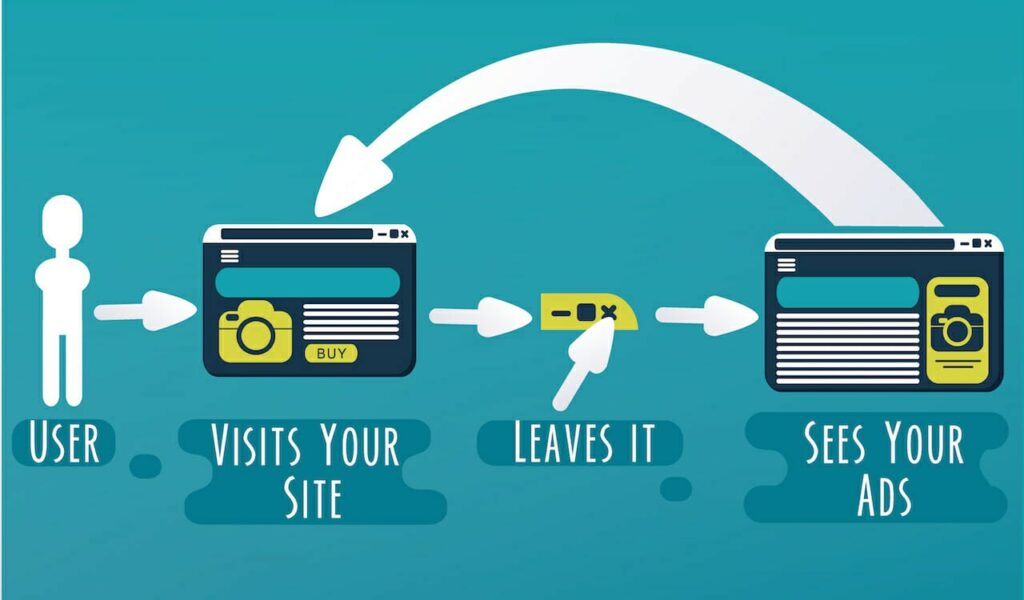
How Online Customer Retargeting Marketing Works
What is Retargeting Marketing?
Retargeting marketing (or retargeting for short) is a type of online advertising used by brands, companies and businesses to ensure their product or service becomes and remains visible to potential customers — even after those potential customers leave their website without making a conversion via a purchase, enquiry or other service.
In other words, retargeting helps brands stay ‘front of mind’ by presenting their ads to people who have already seen their website, or to existing clients listed in their company database.
Retargeting gives the impression of a company’s brand, product or service being ‘everywhere’. This builds familiarity which, in turn, can build a sense of trust:
‘I’ve heard of these guys before…they must be good!’
— Your potential customer
Retargeting in Practice
And now for a real quote 😉
“Retargeting marketing is a great way to bring back the people who have visited your website for the first time, but did not buy.”
— Nick Steeves, Wishpond
Retargeting involves a Javascript code that anonymously ‘follows’ your brand, company or business’s potential clients/customers all over the internet, presenting them with prompts to revisit your site and complete a conversion. Depending on which retargeting services you choose, these prompts could include Facebook ads, google ads, and other advertising services.

Why is Retargeting Necessary?
Are you ready for a shocking stat? Whether your aim is a financial, service or product conversion, the reality is that most websites only achieve a conversion rate of about 2% from a user’s first visit to that website. This is where retargeting comes into the picture, helping companies to reach out to that remaining 98% of unconverted users — and tempting them to choose and commit to your product or service.
Objectives of Retargeting
- Re-engaging your potential customers by building brand awareness
- Ensuring your awareness campaigns appear on pages frequently visited by your potential customers
- Encouraging potential customers to click on your brand’s ads
- Converting potential customers into real customers
How does Retargeting work?
Retargeting works by incorporating ‘cookies’ (the data that is stored in a user’s web browser) that ‘remember’ the users who have engaged with your brand’s webpage or advertisements. Marketers utilize these cookies in order to repetitively and responsively present their brand logo, slogan and/or content, product or service to past visitors of that brand’s website — both unconverted and converted site visitors.
This gives the brand the opportunity to increase their overall conversions, and to raise brand awareness among a greater pool of potential customers.
Retargeting: A step-by-step process
- Potential customer visits your brand’s website
- The user leaves your website without purchasing, enquiring or checking out
- Later on, the user surfs the internet: This could be on Facebook, google searches for unrelated content, etc.
- Your brand advertisement appears and looks familiar, recapturing their interest
- They return to your brand’s website — now familiar and trusted
- The potential customer turns into a real customer
When does Retargeting work?
Retargeting has the potential to be a powerful conversion optimization and branding tool. However, it works best if incorporated into a company’s overall digital strategy from the start — not just as an afterthought.
Retargeting should be thought of as one tool in a full marketing toolbox, which can be used effectively alongside outbound and inbound marketing strategies, AdWords, targeted display and content marketing, in order to drive traffic to your website — and keep it there.
Two Critical Points to Remember When It Comes to Retargeting
1. Retargeting does not target UNKNOWN potential customers
By its very definition, retargeting seeks to reconnect with and convert people who have already interacted with your site. It does not seek out new potential customers, rather it tempts and entices people who have visited your site (or are on your customer database/email list) — but not yet or not recently converted.
The value of this must not be underestimated — retargeting focusses on ‘warm’ contacts, who are already somewhat familiar with your brand, and who are most receptive to what you have to offer. On the whole, converting ‘warm’ contacts is far a simpler exercise than trying to convert a ‘cold’ contact who has no previous experience of your brand.
As a result, businesses and brands who choose to incorporate retargeting into their marketing plan are reporting an incredible increase in their overall Return on Investment compared to digital marketing tactics that do not include retargeting.
2. Your site MUST be user-friendly
Retargeting isn’t going to help increase conversions if your website isn’t functioning properly or geared towards a positive user experience! You can have a thousand revisits to your site — but if it’s hard to use, confusing, forms are broken or it’s just darn unattractive, then you’re just going to lose people again.
Benefits of Retargeting
1. Promotes brand awareness
Retargeting enhances your brand awareness in such a way that your content, slogan and logo will be repeatedly shown to the past visitors of your website. This simple repetitive act will compel people to remember your brand, as well as any specific product or service offerings you make.
2. Return and repeat customer visits are encouraged
Retargeting keeps customer relationships alive. Rather than a one-off encounter, retargeting encourages repeat visits to your site (i.e. encourages repeat customer conversions). You could consider a repeat customer discount (or the like) promotion to encourage another visit and build brand loyalty.
3. Conversion rates will increase
The vast majority of potential customers are reluctant to make a purchase on their first visit to a website. This is why retargeting ads increase the possibility of connecting with potential, returncustomers who are ready to make a purchase.
4. It’s a cost-effective tool
Since a good retargeting strategy focuses on potential customers who are already aware of your brand, you decrease the risk of wasting your advertising budget on ‘cold’ contacts. Retargeting tools hone down to the best audience most likely to convert, instead of going scattershot and wasting your marketing efforts on a wider — but largely disinterested — audience.
Summary
Retargeting promotes your brand’s website to visitors who left your page without engaging on their first visit — ads for your site then ‘follow’ these potential customers, increasing brand awareness, and encouraging them return to your site and make a conversion.
Retargeting is a proven and cost-effective marketing tool, and should be part of your overall marketing toolkit.
Write a comment
Strategist.
Tech Lead.
Digital Marketer.
Feel free to ask if you have a question.
Enter your email below to get our latest posts!